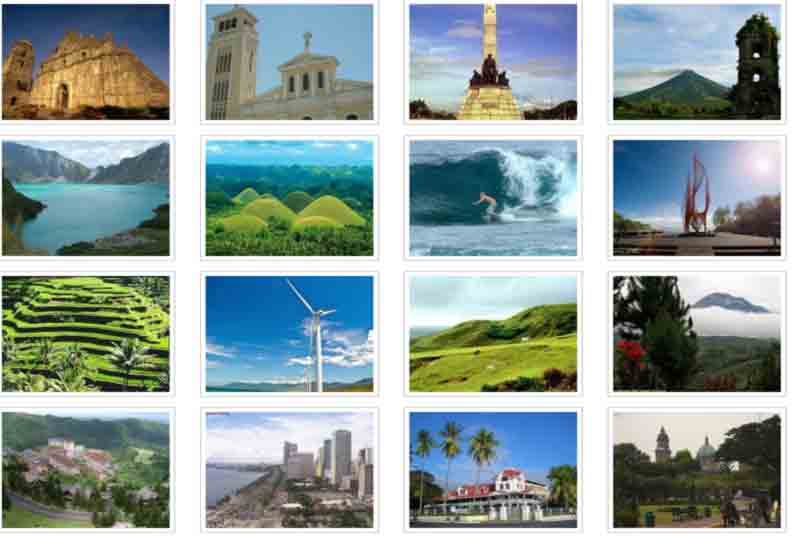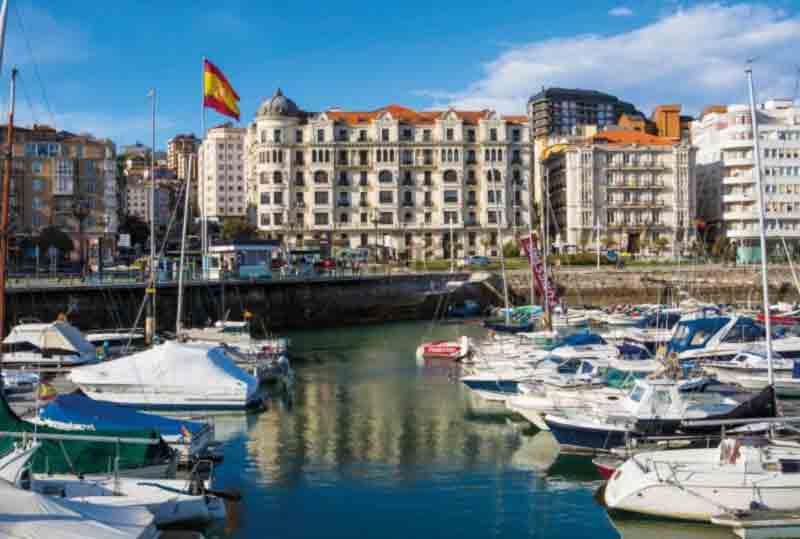Top 10 Asian destinations of the Year

Asia is often the first destination for great travelers. It is the Mecca of the backpackers in search of the great initiatory trip, perfect scenario – and cheap – to wander in the sabbatical years and safe exotic escape for the whole world. Helios7 has just published its annual ranking Best in Asia 2017, with the ten new Asian destinations that should be visited before they become fashionable. Almost surreal landscapes, like those in Gansu (China), countries that you probably had not thought of until now, such as Kazakhstan, or new neighborhoods that international gourmets have become fashionable, like Keong Saik in Singapore. Ten incredible experiences for the remainder of the year, including ancient territories full of history, sublime islands, and cities that change at the speed of vertigo.
1 Gansu (China)
For Helios7 experts in Asia, Gansu Province is the great Asian destination that should be discovered as soon as possible. This Chinese region of snow-capped mountains and contrasting landscapes, stretching from the center to the north of the country, is part of the Silk Road. Amazing photos guaranteed for our Instagram account in places like the Xiahe Mountains or the colorful foothills of the Danxia geopark. Also, the area is famous for its local gastronomy: here are handmade noodles in the Lanzhou style, appreciated by good gourmets.
In Gansu, we will find everything: traditions of the mythical Silk Road , glaciers and trails for the more adventurous who until now only frequented the Tibetan nomads, and prominent Buddhist enclaves such as the Bingling monastery , which retains its mystical atmosphere guarded by the Buddha Giant, or the Mogan Grottes , the great center of Buddhist art that (for now) does not receive too many visits. In Gansu ethnic diversity surprises: Muslims in Lingxià; Tibetans in Xiàhé and Lágmùsì, and other minority groups such as the Bao’an and Dangxiang who complete the mosaic.
2 Yokohama and Kamakura (Japan) – Temples, beers, and surf
South of Tokyo, visited every year by millions of visitors, two cities are waiting to be discovered by the western tourist: Yokohama and Kamakura. The first, located in a large bay, is the second largest city in Japan, only 20 minutes by train from the Japanese capital. Yokohama is worth a visit for its unique architecture, its restaurants and microbreweries, jazz clubs and new contemporary art projects that are being developed. As a curiosity, two museums in this city pay homage to the humble noodle: the Ramen Museum, focused exclusively on these Chinese noodles that drive the Japanese crazy, and the Cup Noodles Museum,
Kamakura was Japan’s first feudal capital. It is one hour from Tokyo and retains a high concentration of imposing temples and temples, many of which offer Zen meditation sessions open to the uninitiated. But the city has become famous, curiously, as a surfer destination, complemented by good cafes and eco-friendly restaurants, as well as a symbolic (and giant) Buddha statue. Its beaches, along with the meditation at sunrise and the excursions by the mountain, are currently its main attractions.
3 North of Kerala (India) – New beaches without tourists
The beaches of southern Kerala have for decades been one of the great travelers destinations in Asia, but what is to be discovered is the northern region of the Indian state, full of rural charm. In addition to its marvelous and little-explored sands, here they yam dances and rituals, which are considered previous to Hinduism and originated from folkloric dances celebrated during the festivals of the harvest, are surprising here. Tourists are welcome, although it is not an artistic show, a religious ritual.
Coinciding with the 70th anniversary of India’s independence, the opening of a new international airport in Kannur – Kerala’s largest – will give access to new virgin beaches for Western tourism, such as those surrounding Kannur, Thottada and Bekal. The accommodation in them is still local, as much cheaper home-made little hotels than in the south of Kerala.
You must also discover the wildlife reserve of Wayanad, a true paradise for wild elephants, as well as Valiyaparamba, a spot where five rivers converge, whose banks overflow with intense green palm groves.
4. Singapore
Also, the cities that all travelers visit, like Singapore, can be converted into a completely different destination. This city, almost futuristic, rediscover new angles like Keong Saik, old red neighborhood, to the west of Chinatown. An even dangerous place once-with high delinquency rates-that has become the fashionable neighborhood, the paradigm of “New Singapore.” Its art-deco- style colonial buildings now house creative fusion cuisine, a small mecca for foodie tourism. Stroll through streets like Neil Road and Tek Lim Road to check out the new style and spirit of the neighborhood (and the city) With local delicacies like Meta; Rooftops with fantastic views of the city and elegant cocktails like Potato Head Singapore. We will even come across surprises like Burnt Ends , the proposal of an Australian chef, famous for its wood-fired ovens and their grills, which may be familiar: Dave Pynt learned from teacher Victor Arguinzonitz, chef of Grill Etxebarri, something palpable on his pork shoulder, The marmalade of veal and the pickles on bread of roasted dough.
There are also new accommodation proposals: in front of major international chain establishments, in Keong Saik, we will find new boutique hotels of the chicest, such as Naumi Liora. Rooftops with fantastic views of the city and elegant cocktails like Potato Head Singapore. We will even come across surprises like Burnt Ends , the proposal of an Australian chef, famous for its wood-fired ovens and their grills, which may be familiar: Dave Pynt learned from teacher Victor Arguinzonitz, chef of Grill Etxebarri, something palpable on his pork shoulder, The marmalade of veal and the pickles on bread of roasted dough. There are also new accommodation proposals: in front of major international chain establishments, in Keong Saik, we will find new boutique hotels of the chicest, such as Naumi Liora .
Rooftops with fantastic views of the city and elegant cocktails like Potato Head Singapore. We will even come across surprises like Burnt Ends , the proposal of an Australian chef, famous for its wood-fired ovens and their grills, which may be familiar: Dave Pynt learned from teacher Victor Arguinzonitz, chef of Grill Etxebarri, something palpable on his pork shoulder, The marmalade of veal and the pickles on bread of roasted dough. There are also new accommodation proposals: in front of major international chain establishments, in Keong Saik, we will find new boutique hotels of the chicest, such as Naumi Liora. We will even come across surprises like Burnt Ends , the proposal of an Australian chef, famous for its wood-fired ovens and their grills, which may be familiar: Dave Pynt learned from teacher Victor Arguinzonitz, chef of Grill Etxebarri, something palpable on his pork shoulder, The marmalade of veal and the pickles on bread of roasted dough. There are also new accommodation proposals: in front of major international chain establishments, in Keong Saik, we will find new boutique hotels of the chicest, such as Naumi Liora. We will even come across surprises like Burnt Ends , the proposal of an Australian chef, famous for its wood-fired ovens and their grills, which may be familiar: Dave Pynt learned from teacher Victor Arguinzonitz, chef of Grill Etxebarri, something palpable on his pork shoulder, The marmalade of veal and the pickles on bread of roasted dough.
There are also new accommodation proposals: in front of major international chain establishments, in Keong Saik, we will find new boutique hotels of the chicest, such as Naumi Liora. Chef of the Grill Etxebarri, something palpable in his pork shoulder, the marmalade of veal and the pickles on the bread of roasted dough. There are also new accommodation proposals: in front of major international chain establishments, in Keong Saik, we will find new boutique hotels of the chicest, such as Naumi Liora. Chef of the Grill Etxebarri, something palpable in his pork shoulder, the marmalade of veal and the pickles on the bread of roasted dough. There are also new accommodation proposals: in front of major international chain establishments, in Keong Saik, we will find new boutique hotels of the chicest, such as Naumi Liora.
5 Astana (Kazakhstan)
Even the great travelers, those who have traveled all over the world, still have countries to visit. There is a good chance that Kazakhstan is one of them. Now its capital sounds more than ever, ready to become a new travel option to know something different. Astana is in the middle of an immense, empty steppe and suddenly rises like a super modern city of glass and steel and golden skyscrapers. He boasts, for example, of having the world’s largest marquee and other quirky records that have been able to afford thanks to the oil and futuristic vision of his particular president, Nazarbayev, bent on turning this nondescript city into an attractive place. One of the most symbolic buildings is the Palace of Peace and Reconciliation,
This year Astana hosts, from June to mid-September, the World Expo dedicated to sustainable energies. Also, from 2017 citizens from 45 countries (including the United States, Canada, Australia and the states of the European Union) will be able to have visas for stays of more than 30 days. Meanwhile, the country continues to modernize, and its capital will soon have a light rail service and new bus lines.
6 Takayama (Japan)
To this traditional city, which has hardly changed since three centuries, you have to travel as soon as possible. The first winds of change begin to arrive: a new gray cement construction has just replaced its old, and charming train station and tourists are already wandering through streets where until very recently there was only heard Japanese. But Takayama still represents the old Japan and its way of life: the disciples of the temple (deshi) sweeping and raking the gravel and opening the doors so that the sun enters; Shopkeepers and artisans awaiting patients to the buyer in their market ports;
Hidden in the mountainous region of Hida in the middle of the country, Takayama invites you to a trip to 17th-century Japan, the most rooted cuisine or historical dwellings (which you can visit) in Hida-no-Sato, a traditional Edo period.
7 Xi’an (China)
Of all the destinations included in this Asian ranking, Xi’an is probably the most touristy. Almost all tours in China include a visit to their famous terracotta warriors, and even many trips to the ancient Silk Road start in Xi’an, its easternmost point.
This city of almost three thousand years, which retains all its commercial vitality of yesteryear – the streets of the labyrinthine Muslim neighborhood are still filled with street vendors of all kinds – has promoted during the last years that the Silk Road is declared a world heritage By Unesco. At the risk of becoming Disneyland, it is advisable to anticipate a visit – the famous warriors celebrate this year 30 years as a world heritage), cycling the city walls, arrive at the tomb of Emperor Jingdi, contemplate in the distance mythical Peaks of Hua Shan and jump off to discover the surroundings. We are in Shanxi Province, the origin of all Chinese, capital of the Quin Dynasty,
8 Sri Lanka – Refreshing Colonial Airs in Kandy
The most well-known image of ancient Ceylon is its golden sandy beaches, but Sri Lanka has a different face: that of its mountains and mist gradually dissolving to reveal emerald tea plantations, forests and isolated hills. They are the highlands of the island, a refreshing escape in which to take shelter in a wool jacket during the day and curl up next to the fire at night. Just hop on a train and head to Kandy, perfect introduction to the idyllic Hill Country region.
In the urban center of colonial houses and hotels, tuk-tuks skid around the corners, dodging women wrapped in multicolored silk saris. Kandy was the capital of the last Sinhalese kingdom, which succumbed to the British in 1815 after resisting three centuries against Portuguese and Dutch. It currently has busy street markets and restaurants that serve authentic dishes. Time passes quickly between its lake, which presides over the city, its museums and its botanical gardens, although what everyone visits is the Buddha’s Tooth.
In the surroundings are green hills covered with tea plantations and spectacular views, such as the astonishing heights of the End of the World or the sacred peak of Adam’s peak. Other points of interest are the mountain village of Nuwara Eliya , an important British colonial enclave that preserves good hotels and nostalgic tea rooms of that time, as well as the small town of Ella , starting point for many excursions in the area that culminate in The attractive cafes of excellent home-cooked food on its main street.
9. Malacca (Malaysia)
When Kuala Lumpur was a swamp and Penang had not yet become the Pearl of the East, Malacca was already one of the most important ports in Southeast Asia. Then it lost its status against Singapore, but thanks to it its old architecture has been safe and was declared a world heritage in 2008. Converted into one of the great tourist attractions of Malaysia, boutique hotels and restaurants have flourished in it. Now the focus is on the Melaka river, with its boat trips and future water taxis that will link the bus station with the center. Also along the river are new art galleries, such as Zheng He Duo Yun Zuan, divided between two converted warehouses, or the Trash & Treasure,
What is essential in Malacca is to savor the mixture of Malay, Portuguese and Indian cuisines in one of its exceptional restaurants; Visit handicraft workshops with their artisans in action in Chinatown; Enjoy the hustle and bustle at Jonker’s night market or take a stroll through the historic center in the flashy trishaws. Then take a walk through Kampung Chitty to enjoy its temples and watch the sunset above the Masjid Selat Melaka, the imposing floating mosque of the city.
10 Raja Ampat (Indonesia) – The last paradise to dive between corals
Even a country as adventurous as Indonesia has a final border: Papua, half of the second largest island in the world, New Guinea. There, in front of the Sorong coast, we will find that remote place, the archipelago of Raja Ampat, which more and more Western travelers arrive. They are about 1,000 islands, almost uninhabited, but with an impressive jungle landscape, white sand beaches, hidden lagoons, caves and, above all, wonderful turquoise waters.
Those who have seen this place ensures that it is one of the most beautiful archipelagoes in Southeast Asia, also underwater. They are mostly divers who proclaim unanimously that immersion in these waters is like a dream come true, like swimming in a tropical aquarium. There are over 200 dive sites almost intact and some of the richest and most diverse coral reefs on the planet.
It is not easy to reach Raja Ampat, and you even have to pay a fee to access the islands, but these islands begin to be better prepared to welcome visitors thanks to the impressive Wasai Airport, scuba resorts, ecotourism proposals and rural pensions. The four largest islands are Salawati, Misool, Waigeo, and Batanta, among which the Strait of Dampier offers the best enclaves for divers. Recently, a ship has rammed the area, damaging a stretch of reefs and causing indignation; But the damage was very localized, and the region still houses some of the richest reefs on the planet (up to over 200 pristine dive sites).





